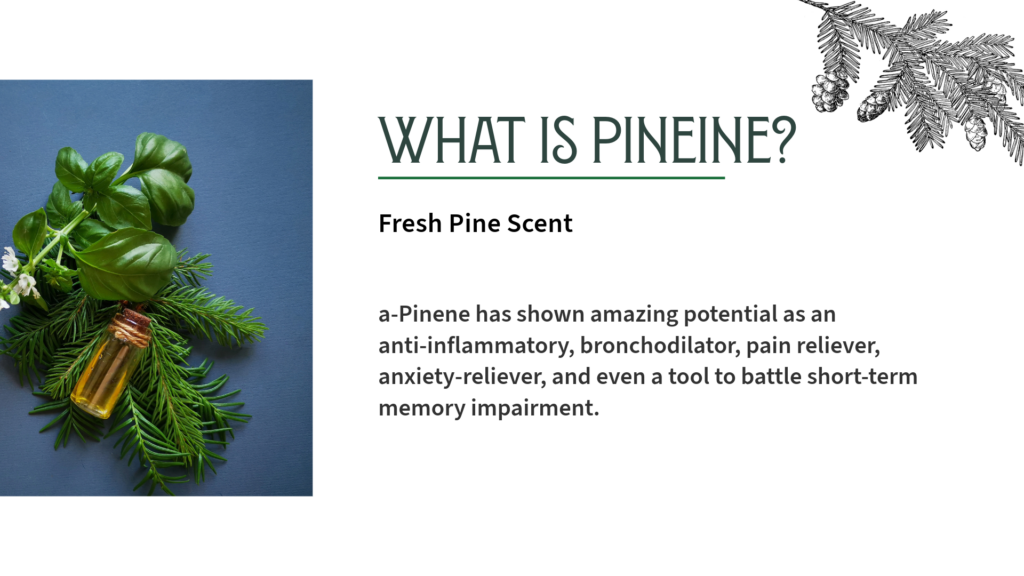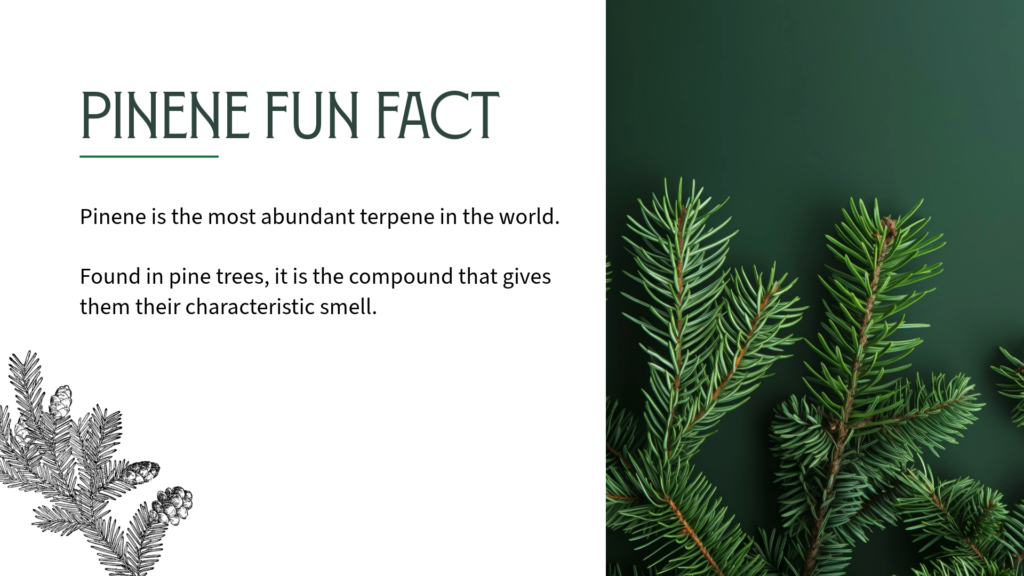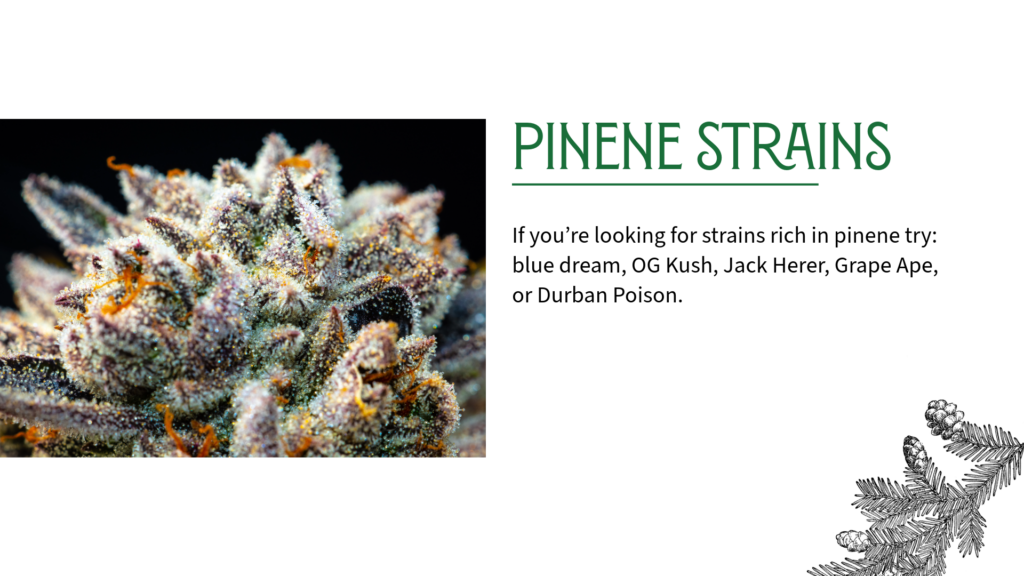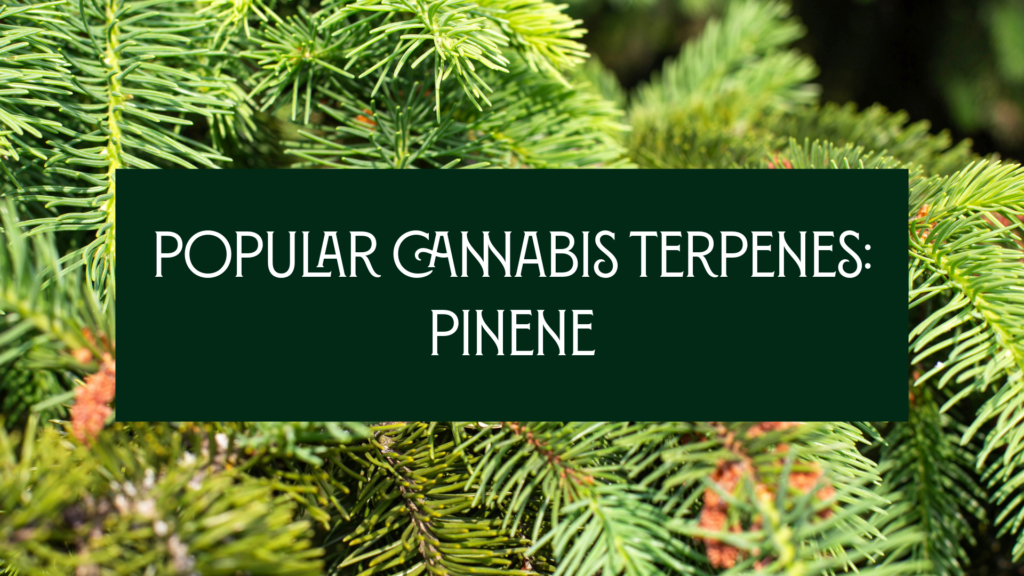Take a moment to imagine the seductive smell of cannabis. You probably conjured up a musky or skunky scent, something pungent and unique. Almost immediately, most people can imagine this scent, similar to how oranges have a vibrant, refreshingly sweet smell or how eucalyptus has that woody, medicinal smell. This distinctive scent profile, like all others in the plant world, is largely due to terpenes.
At Ivy Hall Dispensary, we are dedicated to educating our local cannabis community on all the elements of this wonderful plant. That way, you can be fully informed about the sensory experience you are enjoying.
What Is a Terpene?
Terpenes are fascinating molecules with an expanse of benefits and uses. Terpenes attract pollinators, repel predators, and protect the plant overall. They also have therapeutic, health, and industrial benefits for humans.
Cannabis plants have a naturally high concentration of terpenes. The terpene profile of cannabis plants is influenced by:
- Where it was grown (including indoors or outdoors)
- How much light exposure the plant had
- The choice of growing medium, such as substrate or potting mix
- Nutrient supplementation
- When it was harvested
If you have ever wondered why some cannabis strains have that distinctive piney aroma, this is due to pinene. While around 200,000 different terpenes have been discovered in nature, about 150 terpenes have been found within the Cannabis Sativa L. plant. Each terpene has its own makeup and benefits, but pinene is one of the most prominent and studied terpenes in the world.
What Is Pinene Terpene?

Pinene is a colorless, oily liquid formed within the trichomes, shiny resinous glands that cover cannabis flowers. It can be identified as one of two different isomers, called alpha-pinene and beta-pinene, and most often shortened to a-pinene and b-pinene. While both share a similar carbon makeup, a-pinene has a single bond between the second and third carbon atoms, whereas b-pinene has a double bond.
Even though these might seem like tiny differences, they have quite a significant impact on how the terpene interacts with the body’s receptors. As a result, humans perceive these terpenes differently. A-pinene’s scent is more detectable to the nose, while b-pinene must be concentrated to be detected.
A-pinene is typically more prevalent in Sativa-dominant strains, while b-pinene is often found in Indica-dominant strains. However, with so much genetic diversity within the cannabis plant species, it can be difficult to put strains into neat categories. Thus, just as the exact mix of terpenes can vary quite a bit, so can the concentrations of particular terpenes, including pinene.
Beyond these basics of pinene terpenes, the aromatic profile of pinene cannabis terpenes can truly set strains with pinene apart from other strains. The scent and flavor profile are often a major part of why people enjoy cannabis with high pinene concentrations.
Pinene’s Distinctive Piney Aroma
Think of the aroma that fills your nose while you walk through a damp pine forest or the smell of your living room after you decorate your freshly cut Christmas tree. Pinene is the source of this deep, woodsy aroma that many people find invigorating, and it is truly a classic smell most can identify. Of course, pinene is most abundantly found in evergreen trees like pines, but it is also found in juniper, sage, eucalyptus, basil, citrus fruits, and cannabis.
Within pinene, there are subtle differences in the scent profiles between a-pinene and b-pinene. A-pinene has a fresh, pine-like scent, whereas b-pinene has a sweeter, woody aroma.
Pinene Effects and Benefits
Pinene offers more than just a delightful aroma. It also offers a range of potential health benefits, including:
Anti-Inflammatory Properties
Research suggests that a-pinene reduces the production of cytokines, which can cause inflammation. In fact, many of the benefits of pinene are linked to its anti-inflammatory properties.
Anti-Anxiety and Depressant
Researchers are investigating how pinene might help with anxiety and depression. Due to its anti-inflammatory properties, pinene can help reduce anxiety and depression. It might also help depressive episodes because it reduces levels of cortisol (a stress hormone) and increases the levels of serotonin and dopamine (pleasure and happiness hormones).
Bronchodilator
While more research is needed to fully understand the bronchodilator effects of pinene, current research shows evidence that pinene can help individuals with asthma or other respiratory conditions. Pinene may help relax the muscles in your airways, improving airflow and making it easier to breathe.
Pain Relief
The anti-inflammatory benefits of pinene could be creating another benefit: pain relief. This may be particularly useful for those who suffer from chronic pain. Additionally, pinene might activate receptors in the brain that relieve pain.
Antimicrobial Properties
Pinene has demonstrated antimicrobial properties against bacteria such as Staphylococcus aureus, Escherichia coli, Pseudomonas aeruginosa, and Salmonella enterica. It might also have antifungal properties. Combining these with its aromatic profile has inspired many creators to use pinene in fragrances and cosmetics.
Neurological Benefits
The neuroprotective properties of a-pinene may safeguard brain cells from damage. Some studies even suggest it could enhance focus and alertness. On the other hand, b-pinene has a calming effect due to its aroma, which has potential anti-anxiety and relaxation benefits.
What Are Some Interesting Facts About Pinene?

Pinene is the most abundant terpene in the world, meaning there are plenty of interesting facts to learn.
Interesting Fact #1: Pinene as Traditional Medicine Across Cultures
For ages, people around the world have used pinene in traditional medicine. In traditional Chinese medicine, pine needles were used to treat respiratory issues, pain, and inflammation. In Ayurvedic medicine, pine and eucalyptus were used for breathing issues, fevers, and skin infections.
Indigenous American tribes also recognized the healing power of pinene, using pine needles and other parts of the tree for colds, flu, and skin issues. European peoples embraced pine resin and essential oils derived from pine trees for centuries. Many cultures used it to treat wounds, respiratory infections, and joint pain.
Interesting Fact #2: The Entourage Effect
The entourage effect is a concept that suggests combining various compounds found within the cannabis plant can lead to enhanced therapeutic benefits compared to using only individual cannabinoids. The theory suggests that these compounds work in synergy to amplify the plant’s medicinal properties.
Researchers investigating medicinal cannabis in the late 1990s observed that whole-plant preparations often demonstrated higher efficacy in managing various health conditions as compared to isolated cannabinoid extracts. They discovered this could increase the medicinal value of the cannabis plant due to it working with other terpenes to augment its effectiveness.
Interesting Fact #3: Counteracting Memory Loss
Did you know that some studies suggest that pinene has the potential to counteract memory loss? The terpene has been shown to increase levels of acetylcholine, a neurotransmitter involved in memory and learning. Its anti-inflammatory properties can also counteract cognitive decline and protect brain cells.
Interesting Fact #4: Potential Cancer Treatment
Pinene may have the potential to aid in cancer treatment. It is being explored for its potential anti-cancer abilities, specifically a-pinene. Other research shows that pinene may boost the immune system, directly attack cancerous cells, and reduce inflammation linked to cancer.
Cannabis Strains High in Pinene

If you’re looking for strains rich in pinene, here are some to consider here at Ivy Hall:
Blue Dream
Blue Dream is a cross between Blueberry and Haze strains. This strain is particularly known for its chill, happy vibe. This sweet berry smell is perfect for unwinding, but it won’t knock you out: you can feel good while staying productive.
OG Kush
OG Kush is an “OG” of cannabis strains known for its strong, earthy, citrusy aroma. It provides a balanced high that is both uplifting and great for chilling out. Some individuals choose to use it for its pain and stress relief benefits.
Jack Herer
Jack Herer is a renowned strain known for its potent effects and crazy terpene profile. It’s a Sativa-dominant hybrid, so it gives you an uplifting, energetic buzz perfect for the daytime. It has a complex yet distinctive spicy and aromatic smell.
Grape Ape
Grape Ape is an Indica-dominant hybrid strain that is known for its grapey aroma and flavor. It is a cross between Mendocino Purps, Skunk, and Afghani. Grape Ape helps with relaxation, stress relief, pain management, insomnia relief, and anxiety reduction.
Durban Poison
Durban Poison is a pure sativa landrace strain known for its uplifting and energizing effects. Thanks to pinene, one of its main terpenes, it has a distinct aroma. Many individuals use it during the day to focus, feel good, and get the creativity flowing.
How Can I Really Feel the Effects of Pinene?
If you have decided to experiment with pinene-rich strains, you might be wondering how you can get the most out of your product. Don’t worry! We have some tips on how you can maximize your pinene benefits.
Consider Different Methods to Consume Pinene Cannabis Strains
Pinene cannabis strains can be enjoyed in a few different ways, and each has its own unique vibe.
- Smoking is a classic method, accomplished by lighting up a joint or bowl and inhaling the smoke. It is a quick and easy way to feel pinene’s effects.
- Vaping is another method of inhalation. You’ll need to heat cannabis concentrates to create vapor.
- Edibles offer a more discreet and longer-lasting experience, and these can be anything from gummies to baked goods. The effects can take a while to kick in but can last for several hours.
Ultimately, the best way to consume pinene cannabis strains will depend on your personal preference and desired effects. It is always a good idea to start with a low dose and increase it gradually to find what works for you. Alternatively, consult with the friendly staff at your neighborhood Ivy Hall for more customized advice.
Find High-Quality Pinene Cannabis Strains
To experience the full effects of pinene, you need to choose products from quality sources. At Ivy Hall, we’re dedicated to providing you with a selection of premium quality pinene cannabis strains within our boutique dispensary.
Here are some tips to help you identify if a pinene cannabis product is high quality:
- Take a Whiff – A high-quality pinene strain will have a distinct piney aroma and a slightly sweet, earthy flavor. It should be strong and inviting to your nose, not stale.
- Take a Look – Look for dense, sticky buds covered in milky white or amber trichomes. This means the plant is at optimal maturity. Avoid buds that are dry, brittle, browning, or yellowing.
- Choose Your Dispensary Carefully – Purchase your cannabis from a reputable dispensary like Ivy Hall. This ensures the product is correctly cultivated, harvested, and stored. If you buy from unknown sources, the quality and potency could be questionable.
Terpenes Similar to Pinene
Some terpenes are similar to pinene when it comes to aroma and benefits, including:
- Camphene – Camphene shares an earthy, piney aroma similar to pinene, along with its similar cognitive-enhancing and anti-inflammatory benefits.
- Myrcene – While not as piney, myrcene has a musky, earthy aroma with hints of herbal notes. Like pinene, myrcene is a terpene good for relaxation that is abundant in cannabis.
- Humulen – This terpene has an earthy, woody, and slightly spicy aroma. Like pinene, humulene is anti-inflammatory.
- Caryophyllene – Caryophyllene is an anti-inflammatory and has a spicy, peppery aroma.
FAQs About Pinene Cannabis Terpene
What Is Pinene and Where Is it Found?
Pinene is a common terpene found in many plants, including cannabis, pine trees, orange peels, rosemary, and basil. It is one of the most abundant terpenes in nature, and many people can identify it based on its fresh, piney scent.
What Does Alpha-Pinene and Beta-Pinene Mean?
Alpha-pinene and beta-pinene are two different chemical structures of the same molecule, pinene. They are called isomers, meaning they have the same chemical formula but different atom arrangements. A-pinene has a more pine-like aroma and is found in cannabis, and b-pinene has a woody, herbal scent that is more commonly found in rosemary and basil.
What Are the Effects of Pinene in Cannabis?
Pinene is known to boost alertness, clear your thoughts, improve memory, provide anxiety relief, and soothe inflammation. It even fights off germs through its antimicrobial properties that protect against infection.
Can Pinene Help With Mental Clarity or Alertness?
Yes, pinene can help you think clearer, stay alert, and remember things better. It does this by boosting a brain chemical called acetylcholine, which is important for memory, focus, and learning.
Does Pinene Have Side Effects?
Pinene is generally considered safe, but when used in high doses, it might cause respiratory irritation and skin irritations like redness, itching, and rashes. Dizziness, headaches, and impaired coordination may also occur. It is recommended to consult with a healthcare provider if you have terpene or essential oil sensitivities.
How Does Pinene Interact with THC?
Pinene could potentially offset some of the cognitive side effects of THC use, including memory impairment. This is an example of the entourage effect and highlights how terpenes and cannabinoids can work together to produce stronger effects.
Is Pinene Psychoactive?
No, pinene itself is not psychoactive. While it contributes to the overall effects of cannabis, it does not produce a high on its own.
How Can I Preserve the Terpene Profile when Consuming Pinene-Rich Cannabis?
Pinene can be affected by different consumption methods, such as smoking, vaping, or edibles.
Different consumption methods change the way pinene is released, therefore changing how strong the effects may be felt. Vaping is found to better preserve the terpene profile, but overall, the effects will depend on a person’s metabolism, tolerance, and the strain of cannabis.
Where Can I Buy Cannabis Strains High in Pinene?
Many dispensaries, including Ivy Hall, carry strains high in pinene. You should consult with a budtender for specific recommendations that will fit your goals and desired benefits.
Find Quality Pinene Rich Cannabis Products at Your Local Ivy Hall

Pinene is a superstar terpene found in cannabis plants that packs a punch when it comes to your health. It can fight inflammation, open up airways, soothe pain, battle bacteria and fungus, and even flavor food. Best of all, it is a naturally occurring compound.
Ivy Hall is committed to providing a personalized cannabis experience for our customers. The friendly and approachable staff at any of our nine locations can assist you in finding the right products from our store. We even offer a “terp bar” in our dispensaries to help you determine which terpenes are right for your needs.
Alternatively, you can shop by terpene in our online stores or contact us to learn more.
Sources:
- Calvi, L., Pavlovic, R., Panseri, S., & Giorgi, A. (2020). Cannabinoid profiling in cannabis sativa L. inflorescence and hashish for recreational purposes. Frontiers in Psychiatry, 11, Article 583211. https://doi.org/10.3389/fpsyt.2021.583211
- Giacomelli, C., Trincavelli, M. L., & Minocci, D. (2015). Cannabinoid modulation in neuropsychiatric disorders: Emerging evidence for the effectiveness of cannabigerol. Pharmacological Reviews, 73(4), 1269-1280. https://doi.org/10.1124/pharmrev.122.000334
- Hill, K. P., Palastro, M. D., Johnson, B., & Ditre, J. W. (2017). Cannabis use and risk of prescription opioid use disorder in the United States. Pain Medicine, 19(2), 331–335. https://pubmed.ncbi.nlm.nih.gov/36978347
- Hindocha, C., Freeman, T. P., Grabski, M., & Bloomfield, M. A. P. (2019). The relationship between cannabis use and psychosis: A review of the clinical evidence and potential biological mechanisms. International Journal of Neuropsychopharmacology, 25(2), 127–135. https://pmc.ncbi.nlm.nih.gov/articles/PMC7763918/
- Karniol, I. G., Shirakawa, I., Kasinsky, N., Pfeferman, A., & Takahashi, R. N. (1975). Effects of cannabidiol in animal studies and humans. European Journal of Pharmacology, 31(2), 233-242. https://pubmed.ncbi.nlm.nih.gov/25242385/
- Kumar, A., & Yadav, S. (2023). Pinus ponderosa: Its chemical constituents and pharmacological importance. Ayurvedic Herbal Journal, 16(3), 245-252. https://ayurveda.alandiashram.org/ayurvedic-herbs/ponderosa-pine-pinus-ponderosa
- Martinelli, G., Gandini, C., Truzzi, F., & Frabetti, A. (2023). Influence of cannabinoids on the pineal gland and their impact on circadian rhythms. Journal of Pharmacological Studies, 34(1), 45–62. https://pmc.ncbi.nlm.nih.gov/articles/PMC10081257
- Schrot, R. J., & Hubbard, J. R. (2021). Cannabinoid-based treatments for pain and inflammation: A review of the clinical evidence. Current Pain and Headache Reports, 26(3), 101–115. https://pmc.ncbi.nlm.nih.gov/articles/PMC6920849/
- University of Vermont. (n.d.). Medicinal properties of white pine. UVM Library Exhibits. https://libraryexhibits.uvm.edu/omeka/exhibits/show/uvmtrees/whitepine/medicinal
- Wen, X., & Chen, T. (2021). Pinus ponderosa in traditional Chinese medicine. Chinese Nutrition Journal. Retrieved from https://chinesenutrition.org/view_image.asp?pid=711
- Zhang, L., Gu, H., & Chen, Y. (2023). Cannabinoid pharmacology: Emerging roles of CBD and THC. Clinical Neuropharmacology, 39(4), 455–467. https://pmc.ncbi.nlm.nih.gov/articles/PMC9506106/
- Zhou, X., Wu, X., & Li, L. (2023). The effects of cannabinoids on metabolic syndromes: A clinical review. Journal of Clinical Pharmacology, 38(3), 243–258. https://pubmed.ncbi.nlm.nih.gov/37535820/
Zhu, H., Chen, Y., Wang, L., & Xu, Z. (2023). Cannabinoid and terpene interactions in cannabis therapy: A meta-review. Clinical Therapeutics, 45(2), 101–116. https://pmc.ncbi.nlm.nih.gov/articles/PMC8426550/
